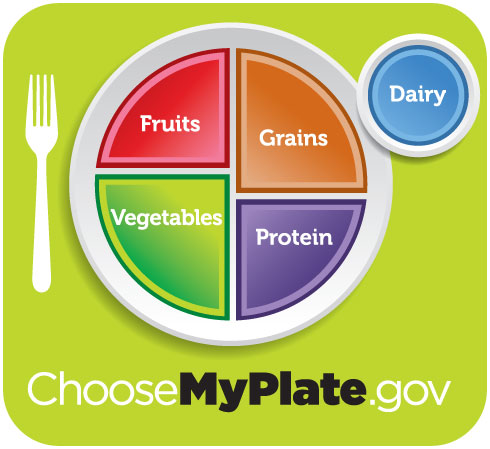
1. Balance Calories
As the first step in managing your weight, find out how many calories your body needs per day by visiting www.MyPlate.gov. Being physically active will also help you balance calories.
2. Enjoy Your Food, But Eat Less
Take the time to fully enjoy your food. Eating too fast or when your attention is elsewhere may lead to overeating. Pay attention to hunger and fullness cues before, during, and after meals. Use them to recognize when to eat and when you have had enough.
3. Avoid Oversized Portions
Use smaller plates, bowls, and glasses. Portion your foods before you eat. When eating out, choose a smaller size option, share a dish, or take home part of your meal.
4. Foods to Eat More Often
Eat more vegetables, fruits, whole grains, and fat-free or 1% milk and dairy products. These foods have the nutrients you need for health, including potassium, calcium, vitamin D, and fiber. Make them the basis for meals and snacks.
5. Make Half of Your Plate Fruits and Vegetables
Choose red, orange, and dark-green vegetables such as tomatoes, sweet potatoes, and broccoli, along with other vegetables for your meals. Add fruit to meals as part of main or side dishes or as dessert.
6. Switch to Fat-Free or Low-Fat (1%) Milk
Fat-free and low-fat milk have the same amount of calcium and other essential nutrients as whole milk, but fewer calories and less saturated fat.
7. Use Whole Grains as Half of Your Daily Grain Allowance
To eat more whole grains, substitute a whole-grain product for a refined product, such as eating whole wheat bread instead of white bread, or brown rice instead of white rice.
8. Foods to Eat Less Often
Cut back on foods high in solid fats, added sugars, and salt. These include cakes, cookies, ice cream, candies, sweetened drinks, pizza, and fatty meats such as ribs, sausages, bacon, and hot dogs. Use these foods as occasional treats, not as everyday foods.
9. Compare Sodium in Foods
Use Nutrition Facts labels to choose lower sodium versions of foods such as soups, breads, and frozen meals. Select canned foods labeled “low sodium,” “reduced sodium,” or “no salt added.”
10. Drink Water Instead of Sugary Drinks
Cut calories by drinking water or unsweetened beverages. Soda, energy drinks, and sports drinks are a major source of added sugar and calories in American diets.